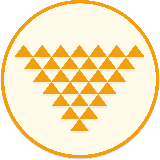Introduction
Symmetry is a captivating aspect of many natural and human-made objects, offering a sense of balance and harmony. In typography, symmetry plays a crucial role, especially in the design of capital alphabets. This blog delves into the symmetry found in capital letters, illustrating how it enhances visual appeal and aligns with fundamental geometric principles.
What is Symmetry?
Symmetry refers to a balanced and proportionate similarity between two halves of an object. In simpler terms, if you can divide an object into two identical parts, it is symmetrical. There are various types of symmetry, including reflective (or mirror) symmetry, rotational symmetry, and translational symmetry. In the context of capital alphabets, we primarily focus on reflective symmetry.
Reflective Symmetry in Capital Alphabets
Reflective symmetry occurs when one half of a shape is a mirror image of the other half. Many capital letters in the English alphabet exhibit reflective symmetry, either vertically or horizontally.
- Vertical Symmetry: Letters such as A, H, I, M, O, T, U, V, W, X, and Y have vertical symmetry. If you draw a vertical line down the middle of these letters, both halves mirror each other.
- Horizontal Symmetry: Letters like B, C, D, E, and K exhibit horizontal symmetry. When you draw a horizontal line through the center, the top and bottom halves are mirror images.
Non-Symmetrical Letters
Not all capital letters possess symmetry. For instance, letters like F, G, J, L, N, P, Q, R, S, and Z lack symmetry, making their design unique and diverse. The absence of symmetry in these letters contributes to the overall balance and variety within the alphabet.
Why Symmetry Matters in Typography
Symmetry in typography is more than just an aesthetic choice; it has practical implications as well.
- Readability: Symmetrical letters are often easier to read and recognize, enhancing the clarity of written text.
- Design Harmony: Symmetry brings a sense of harmony and balance to text, which is particularly important in graphic design and branding.
- Visual Appeal: Symmetrical letters are visually pleasing, contributing to the overall attractiveness of a design or text.
Exploring Symmetry in Design Projects
Understanding the symmetry of capital alphabets can significantly impact various design projects, from logo creation to poster design. Here are a few ways to incorporate symmetry effectively:
- Logo Design: Utilize symmetrical letters to create logos that are balanced and visually appealing.
- Typography Art: Explore creative typography projects that highlight the symmetry in capital letters.
- Educational Tools: Use symmetrical letters to teach geometric concepts and symmetry to students.
Conclusion
The symmetry of capital alphabets is a fascinating intersection of art and geometry. By understanding and utilizing symmetry, designers and typographers can create visually appealing and harmonious works. Whether you are a designer, educator, or simply a typography enthusiast, exploring the symmetry of capital letters offers valuable insights into the principles of design and aesthetics.
Leave a comment
Your email address will not be published. Required fields are marked *




